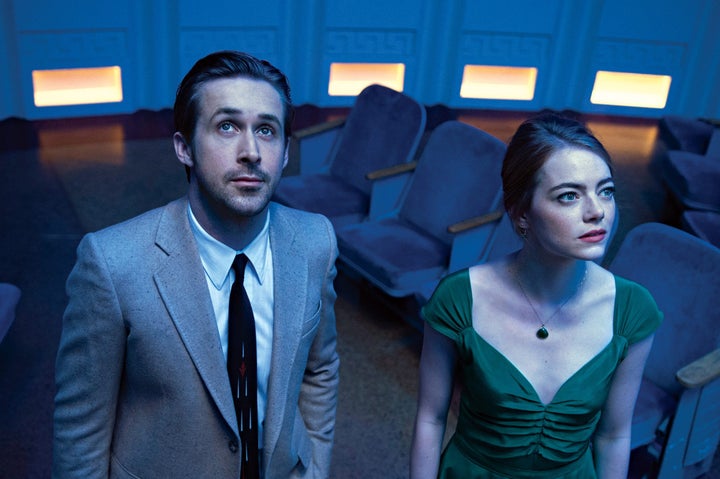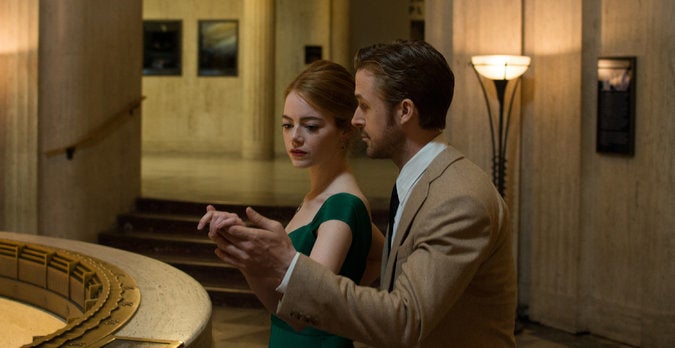
It’s almost too easy to applaud “La La Land” for its nostalgic twinkle. A luminous callback to the MGM musicals that pervaded the 1940s and ‘50s, Damien Chazelle’s new movie romanticizes a genre that has largely atrophied. Hollywood is forever a fiend for self-homage, and cinema’s legacy forms this film’s blueprint. But a genre revival is hardly the most interesting thing about it.
Many have called “La La Land” the “Singin’ in the Rain” of 2016. They’re not wrong. Yet the endeavor does more than resurrect a dormant filmmaking style. It invokes our collective envy of life as it appears on the big screen, pondering the wish fulfillment that stems from a century of going to the movies. We all want to live in a storybook. We’d like showtunes to accompany milestones and choreographed dances to punctuate moments of whimsy.
In “La La Land,” they do, and for good reason. Early in the film, when the roommates of aspiring actress Mia Dolan (Emma Stone) drag her to a party to shake off a foul audition experience, they wheedle her with a song-and-dance number proclaiming that “someone in the crowd could be the one you need to know / the one to finally lift you off the ground.” Mia is convinced. The ditty continues well into their arrival at the swank shindig, where its premonition proves true, sort of: Mia abandons the gala and, strolling through the Los Angeles streets solo, finds herself lured into a nightclub where a pianist (Ryan Gosling) plucks at one of the soundtrack’s signature songs, the dreamy “Mia and Sebastian’s Theme.” It’s the second time she’s seen him. The first encounter came in the dynamite opening scene, when they flipped each other the bird at end of a traffic jam in which drivers turned their stalled treks into a sunny dance spectacle.

This prolonged meet-cute resurfaces again at a pool party where said pianist, named Sebastian, plays in a mediocre cover band that no one pays much attention to. Mia and Sebastian banter sardonically and wind up leaving at the same time, igniting a spark that sends them jittering through a highland overlooking the starry Hollywood Hills.
If the idea of toiling artists reencountering each other in a sprawling city and romancing their way to contentment sounds corny, that’s the point. “La La Land” is a tale of artifice. Spotlights enshrine characters’ solos, onlookers join their hyperstylized dance numbers, and Mia and Sebastian concoct a reverie through Griffith Observatory, where they literally soar across the planetarium’s stars. But this pair, and the movie itself, are too self-aware to be reduced to emblems of a pat romantic comedy. They foster the contrivances as though waltzing through a dream, having spent their lives aspiring to the same storybooks we all do. Mia’s hopes would take her from slinging coffee on the Warner Bros. studio lot to becoming a star actress, and Sebastian’s would carry him from low-rent gigs to the ownership of his own jazz club. If courtship aids in fleeing the doldrums of unfulfilled dreams, why shouldn’t it be grand? Why shouldn’t it be the stuff that old movies are made of?

As “La La Land” progresses, and as Sebastian and Mia face more career hurdles, the artifice dissolves. Musical numbers become less frequent, and the strain of the characters’ twin aspirations sets in. Sebastian lands a spot in his friend’s (John Legend) band, sending him out on the road for long stretches. Mia shells out a hefty penny to mount a one-woman show. Reality intervenes. The storybook isn’t as tidy as the movies taught us to expect.
Through it all, Chazelle remains in love with the world his film inhabits. Like most vintage musicals, it’s art-directed to a T, shot by Linus Sandgren to emphasize the vibrant color patterns of any given sequence. During the party Mia attends in the first act, when a reveler leaps from a balcony into a pool, the camera plunges into the crisp blue water with him. It bobs in and out of the waves, creating a swirl of charisma that crackles as dancers’ wardrobes shimmer. Later, during the film’s highlight, Mia tells a melancholy story of her aunt diving into the Seine River in Paris. The lights around her fade, and it is just Stone singing an ode “to the ones who dream, foolish as they may seem.”

That electric charm distracts from a slight sag in the middle of “La La Land,” once the template is established but before the movie shifts into its culminating sentiments. Though Gosling and Stone are not especially remarkable singers, they boast a modernity that feels more appropriate than their ability to belt notes. As Sebastian and Mia, they are naturalistic and beguiling, particularly Stone. Between affectionate snipes, they ease into songs, controlled by the delicate crescendoes of Chazelle, who used the tempo of drumbeats to steer the rumbling “Whiplash” and tap-dancing to anchor the jazz musical “Guy and Madeline on a Park Bench.”
Chazelle has crafted a 20-minute finale so note-perfect that it justifies every flourish of the film’s breezy first half. It’s a twirl of bittersweet magic, a dream ballet worth equal parts cheers and tears. Most significantly, It’s a dynamo celebration of the dreams we’ve invented by going to the movies, where life feels limitless. Sometimes it’s OK for the movie to end.
“La La Land” opens in limited release Dec. 9. It expands to additional theaters throughout December.
Correction: An earlier version of this post indicated Mia is lured into Sebastian’s nightclub as he plays “City of Stars.”

